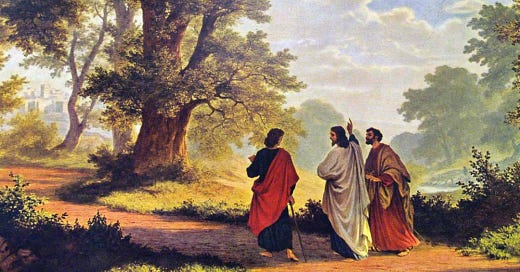Luke 24- The Road to Resurrection
I want to go deeper into the resurrection narratives. I really see a pattern that is vitally important to us all.
The pattern is the three occurrences of Jesus appearing to his disciples and they do not recognize Him at first. Why is this a pattern? What does it mean to us?
In Luke 24, we are given the story of two disciples who walked with Jesus on the road to Emmaus. These two disciples are talking about Jesus, and the resurrected Jesus joins them on their journey. (Jesus said, “where two or three are gathered in my name, there am I in the midst of them,”). Following the pattern of Mary Magdalene in the garden, the two disciples do not recognize Jesus.
The text says, “their eyes were kept from recognizing him.” This speaks of a force stopping them from seeing Jesus. The text does not tell us the source of this force. When we speak of our eyes deceiving us, we speak in metaphor, because our eyes are simply a lens system that gathers information, and our brain is what actually “sees” reality. So, there was a force in their mind that was keeping them from recognizing Jesus.
These two disciples could talk about Jesus, walk with Jesus, receive an extensive Bible study from Jesus, and still not recognize Jesus. And if this happened to them, it can happen to us.
An Incomplete Jesus
The two disciples knew an incomplete story of Jesus. I believe an incomplete story of Jesus causes us to not see the complete Jesus, who walks with us.
The disciples knew the ministry, the miracles, and His death on the Cross. They had also heard the rumor of resurrection, but they were confused and disillusioned. They told Jesus about their hopes for Jesus: “We had hoped He was the One to redeem Israel.” This tells us that they had a story in their minds of what Messiah would look like. Jesus did not look like their story, so they did not see the real Jesus as they walked with Him.
Jesus responds to their confusion with a Bible study. “Beginning with Moses and all the Prophets.” Jesus told them how the Scriptures speak of the necessity of a Messiah who enters his glory through suffering. Their hearts were touched with the fire of His word, but they still do not recognize Him.
It only took Jesus speaking her name for Mary Magdalene to recognize the Lord (John 21: 16). For the two disciples, it took an action to reveal Him. Jesus re-enacted what He did at the feeding of the five thousand (Luke 9:16). Jesus “took the bread and blessed and broke it and gave it to them.” This action “opened their eyes” and they recognized Him, and then he vanished from their sight.
The bread did not show them. The Bible study did not show them. The blessing did not show them. Jesus was not revealed until He broke the bread and gave it. When they received the broken bread, they were made whole.
The essence of worship is re-enactment. All the feasts of Israel, beginning with Passover, are re-enactments of the work of God for His people. When we sing and praise God in our weekly services, we re-enact the heavenly host and the saints of Revelation before the throne. In worship, we join “every family in heaven and on earth” that is named by their connection to Jesus (Eph. 3:15). The Eucharist, what we call “communion,” is a re-enactment of the Last Supper of Jesus, “the night he was betrayed.” We see Him, “who inhabits the praises of Israel.” (Ps. 22:3) when we see the broken bread. We “proclaim the Lord’s death until He comes.” (1 Cor. 11:26).
Many in the church do not see Jesus, not because He is not there, but because they believe an incomplete story. What holds us back from seeing Jesus is an incomplete story that gives us an incomplete Jesus. We are broken when we do not see Him in the breaking of the bread.


